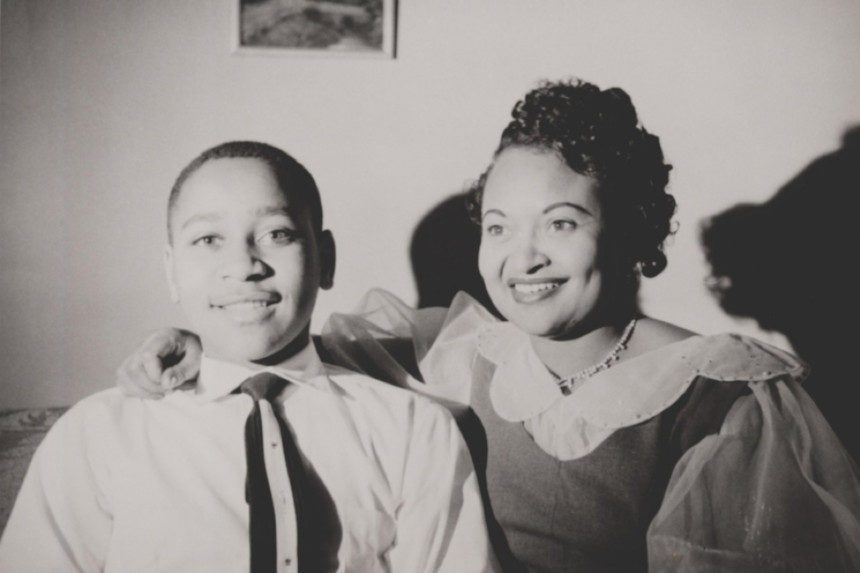This series by American studies professor Ben Railton explores the connections between America’s past and present.
In the early morning hours of August 28, 1955, Roy Bryant and J.W. Milam abducted and lynched Emmett Till near the small town of Money, Mississippi. Till, who had just turned 14 years old a month earlier, lived in Chicago with his single mother Mamie; Mamie’s parents had left Mississippi as part of the Great Migration when she was just two years old, and in the summer of 1955 Emmett returned to the area for the first time, staying with Mamie’s uncle Mose Wright and his family. On the morning of August 24 Emmett and his cousin Curtis visited Bryant’s Grocery and Meat Market, where 21-year-old Carolyn Bryant was working by herself; according to Bryant’s testimony at the time, Emmett accosted her both verbally and physically. When her husband Roy returned from a fishing trip on August 27, Carolyn told him her version of the encounter, and he and his half-brother J.W. set out on a mission of revenge and racial terrorism that ended with the brutalizing and murder of Emmett.
Virtually every detail of Till and Bryant’s initial encounter remains in dispute, not least because Carolyn Bryant herself has in recent decades recanted some crucial aspects of her testimony (such as the physical side to the altercation). Roy and J.W.’s lynching of Emmett was never in dispute, yet the two men were acquitted on all charges by an all-white jury in a high-profile September 1955 trial. All those histories tell us a great deal about Mississippi, the South, and America, in 1955 and in our own moment. Yet there is another vital side to our collective memories of Emmett Till, one captured by his moving memorial at the National Museum of African American History & Culture.
The centerpiece of the NMAAHC’s Till memorial is his casket — not a replica, but the actual casket in which Till was buried after his early September funeral in Chicago. The Department of Justice exhumed Till’s remains as part of a 2005 investigation into his kidnapping and murder, and he was re-buried in a new casket; the old casket was stored at the cemetery and discovered in 2009. The NMAAHC, still in development at the time, acquired the casket soon after; as Director Lonnie Bunch III put it, “It is an object that allows us to tell the story, to feel the pain and understand loss. I want people to feel like I did. I want people to feel the complexity of emotions.”
When I visited the NMAAHC with my sons and my parents a couple weeks ago, it was indeed the Till memorial that most affected us all (which is no slight on the whole of this must-visit museum). We did feel that pain and understand that loss, as it’s impossible not to contrast the exhibit’s photos of young Emmett (as a baby, as a young boy alongside his mother, and as a smiling teenager just months before his murder) with the photos and stories of his lynching and, most potently, with that adolescent-sized casket, past which visitors to the memorial walk as if at a funeral service.
As that casket reminds us, the pain and loss of Emmett’s lynching was felt with particular force by Mamie. She had already lived through more than her share of struggle, including her family’s migration, her parents’ divorce when she was 13, and, especially, her abusive marriage with Emmett’s father Louis Till. They were only 18 when they married in 1940, and he was consistently abusive, culminating in his choking Mamie to unconsciousness in 1942 (when Emmett was about 1). After that assault she took out a restraining order on Louis, and when he violated it repeatedly he chose enlistment in the army rather than prison. In July 1945 Louis was court-martialed and executed in Italy for murder and rape, leaving Mamie and Emmett as a pair of survivors, a tight family unit on Chicago’s South Side.
For a parent to lose their child in any way is a tragedy; for Mamie to lose her only child in this sudden and brutal manner is a trauma too horrific to imagine. Yet as the museum’s open casket likewise reminds us, Mamie responded to that trauma with a pair of stunning and crucial choices: making Emmett’s funeral service public and, most potently, insisting on an open-casket service. “I wanted the world to see what they did to my baby,” she argued, and tens of thousands of mourners did see Emmett’s brutalized young body (with photographs being seen by millions more). Mamie then embarked on an NAACP-organized speaking tour, sharing her loss and trauma and son and voice with audiences around the country.
As the NMAAHC’s exhibit highlights in depth, Mamie’s choices became hugely inspirational for the nascent Civil Rights Movement and some of its most significant figures and actions. As Myrlie Evers put it, “Somehow [it] struck a spark of indignation that ignited protests around the world. … It was the murder of this 14-year-old out-of-state visitor that touched off a world-wide clamor and cast the glare of a world spotlight on Mississippi’s racism.” Or, as Rosa Parks put it more succinctly, when describing to Mamie Till herself the moment when Parks refused to move to the back of that Montgomery bus, “I thought of Emmett Till and I just couldn’t go back.”
The recent launch of the New York Times’s 1619 Project has prompted renewed debate about whether and how to remember our nation’s most violent and oppressive histories. Critics of the project (those not blatantly advancing white supremacist talking points) argue that dwelling on these painful histories is divisive and destructive to our present and future. Yet until we can feel the pain and understand the loss, how we can possibly grapple with not only the histories themselves, but the nation that has featured them so consistently and centrally? We can only do so by standing before the casket — and when we do, we can also remember the ways in which figures like Mamie Till, Rosa Parks, and so many more have experienced and yet transcended our worst, modeling the best of what we might still become.
Featured image: Emmett Till with his mother, Mamie Bradley, ca. 1950 (Alamy)
Become a Saturday Evening Post member and enjoy unlimited access. Subscribe now




Comments
Correction: I meant “in life” in sentence two. (Thank you.)
This is still a horrific, senseless crime that’s still shocking today, 64 years later. On a personal level I see a mother who had already been brutalized/traumatized by her own husband life many years earlier, trying her best to make a decent life for her son and herself.
Reading about what Mamie had gone through in the 1940’s made this all the more painful to read. The picture of this lovely mother and her son, her only child, makes this a story unbearably tragic. I’m glad (at least) that the story lives on into the present, because it needs to.
Hopefully someway, somehow, continued understanding of America’s racial problems and tensions will subside and improve. It seems like much of the progress made in these areas in the later 20th century decades has disappeared in the 21st, particularly during this disastrous 2nd decade, only several months from ending.
As a nation we have yet to figure out the solution. Part of the problem is when progress is made, those who made it possible are replaced by another generation that doesn’t know (or want to know) how to keep the peace; that likes causing trouble and upsetting things, sending everything back basically to square one.
It’s a well known fact this nation’s colleges and universities are hotbeds for racism and hatred. Traditionally it’s been directed at blacks (and still is) but in the past few years there’s been a big resurgence in Hitler/Nazi activity in addition. It’s time the evil, nasty roaches at THESE institutions were exposed big time, and effectively sprayed with Raid, Professor Railton.